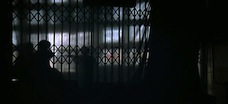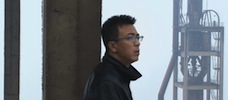Reviews
Sanxia Haoren / The Good People of the Three Gorges
Jia Zhangke
China / Hong Kong, 2006
Credits
Review by Michael Nordine
Posted on 31 May 2011
Source New Yorker DVD
Related articles
Still Life by Leo
Categories Jia Zhangke’s Migrations
Though firmly, inescapably rooted in the real, Still Life has its head in the clouds. So as not to lose sight of their shared past, the denizens of Jia Zhangke’s strange-but-easily-imagined world distract themselves with dashes of the supernatural: magic shows, fire-breathers, and tightrope-walking are common sights. As with the film’s interlocked, but separate narrative threads chronicling a man named Sanming in search of his daughter and a woman named Shen looking for her husband, these diversions are part of a larger attempt by these characters to rediscover, if not recreate vital aspects of their former lives. But rather than accept and move on from their past, Jia’s characters often cling to it instead—and find themselves further gone than they were when they started.
That Sanming and Shen never meet - and thus never discover that they’re not alone in their meandering from place to place, thread to thread - solidifies Still Life’s foundational loneliness. Were the two wanderers to cross paths, however, there’s little to suggest they’d be of much help to one another: Sanming hopes to reconnect with his family, while Shen wants a divorce. The distinction between their goals is paramount, but the end results are largely the same. Jia, ever the disinterested observer, gives no hint as to whether he considers one of them to be more “right” than the other in their intent, but it’s clear enough that neither of them makes it out of their ordeal unscathed. There’s a certain affection in Jia’s depiction of these two lost souls, as though the director himself knows more than a little of looking to the past when confronted by the inexorable force of the future.
Political as well as personal, Still Life is set on the misty, quickly disappearing banks of China’s famed Yangtze. The river’s status as a symbol of that country’s globalization goes without saying in recent years, but Jia doesn’t use it to quite the same effect as, say, Yung Chang’s Up the Yangtze. Both use the Three Gorges Dam as a starting point, but where Chang highlights class issues, Jia presents his film’s (and region’s, and country’s) defining geological attribute as a means of looking at the loneliness wrought by connectivity. Construction of the dam displaced well over one million people, and waves - of water and of electricity - are just as capable of sweeping us away from one another as drawing us closer together.
In Still Life, the have-nots left in the watery wake of China’s global expansion encompass many walks of life: factory men, prostitutes, construction workers. The human faces of an increasingly industrialized movement to strengthen China, many of them are nameless, marginalized figures whose only solace is each other’s company (and sometimes not even that). Many of these men and women do what they can to point Still Life’s two wanderers in the right direction, but others, such as a man who advises Sanming against “stirring up the past,” are more guarded. Remarkably, this subtle critique of Jia’s homeland is state-sanctioned: as he did with The World, the director worked within the Chinese Film Bureau rather than around it, a choice that ultimately granted him more artistic freedom than one might expect of a system that’s quick to control the flow of information. Although he does so in a necessarily oblique way, Jia makes it clear enough that his country favors the collective over the individual.
To focus too much of one’s attention on the political arm of Still Life, however, is to run the risk of missing Jia’s more intimate, overarching notion that even those closest to us - children, spouses, siblings - can pass through our lives like strangers. To search for something that isn’t there is to be wholly alone, a wanderer for whom there is to be little consolation. But there’s more than one way to be lost, and it can be just as disheartening to find what it is you’ve been looking for only to realize that it bears little resemblance to your memory of it. People change; so does the land. Forlornly holding onto the way things once were will most often lead to being swept away by the forward march of time and progress, a stubbornness Jia admires even if he highlights its eventual folly.
These concerns are present in The World as well, though they often materialize in brighter, more garish displays. Aesthetically quieter than that film, Still Life’s embellishments are comparatively scarce but no less striking when they occur. The focus here is more on water and soil than manmade wonders, the dam’s formidable presence notwithstanding. Characters are constantly asking about the many different regions from which their new acquaintances hail; in a land as vast as this, some countrymen are as foreign to one another as they are bound by the same restrictive rules. Search takes precedence over results here, and those sought out by Sanming and Shen always seem to have just left wherever it was they were said to be. Any and all communication that doesn’t take place in person is useless: computers break, phones are turned off. In this way, it’s the opposite of the hyperlinked The World, in which text messages are ubiquitous and one can simply take the monorail from one part of that film’s self-contained world to another. Though the sights and sounds of Still Life are far more understated, they’re no less captivating.
There are two glaring exceptions to this understatement: a UFO that signals the transition between the film’s two halves and a building that launches itself into the air like a self-propelled rocket. In neither case does anyone react to them as though they’re any stranger than anything else which has happened that day. The surreality of these moments, jarring though they are, seems to pale in comparison to the ways in which Sanming and Shen’s lives have already been irrevocably altered. Jia draws a fine line between the corporeal and ethereal here and elsewhere in Still Life, a fitting means of highlighting the inherent unbelievability of one’s way of life disappearing underwater.
More Jia Zhangke’s Migrations
-

Xiao Wu
1998 -

Unknown Pleasures
2002 -

The World
2004 -

Useless
2007 -

Still Life
2006 -

Dong
2006 -

24 City
2008
We don’t do comments anymore, but you may contact us here or find us on Twitter or Facebook.



